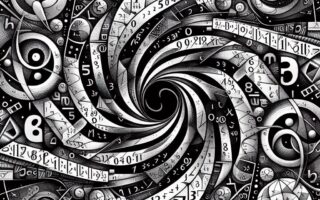The History of the Indian Decimal System
The Indian decimal system is one of the most significant advancements in mathematics, fundamentally changing how numbers are represented and calculated. Originating in ancient India, this numeral system laid the groundwork for modern mathematics and has influenced various scientific fields. In this blog post, we will explore the history of the Indian decimal system, its key features, notable mathematicians who contributed to its development, and its far-reaching impact on mathematics and science.
Origins of the Indian Decimal System
The Indian decimal system, also known as the Hindu-Arabic numeral system, is characterized by its base-10 structure and the use of positional notation. This means that the value of a digit depends on its position within a number. For instance, in the number 243, the digit 2 represents two hundreds, the digit 4 represents four tens, and the digit 3 represents three units.
The roots of the decimal system can be traced back to the ancient Indian civilization around the 6th century CE. The earliest known records of the decimal system appear in the Bakhshali Manuscript, a mathematical text dated between the 2nd and 4th centuries CE. This manuscript contains methods for arithmetic calculations and demonstrates the use of a dot to represent zero, a critical innovation in mathematics.
The first explicit use of the numeral system is attributed to the mathematician Aryabhata (476–550 CE), who introduced a systematic approach to arithmetic and algebra. Aryabhata’s work, Aryabhatiya, included rules for computation, and his insights into the place value system paved the way for the development of the decimal system.
Key Features of the Indian Decimal System
- Positional Notation: The positional nature of the Indian decimal system allows for a compact representation of large numbers. Each digit’s value is determined by its position, enabling efficient arithmetic operations.
- Use of Zero: The introduction of zero as a numeral was revolutionary. It served as a placeholder, allowing for the differentiation between numbers like 10 and 100. This innovation simplified calculations and laid the foundation for higher-level mathematics.
- Base-10 System: The base-10 structure is intuitive and aligns with human counting, making it accessible and widely adopted.
- Numerical Symbols: The symbols used in the Indian decimal system underwent evolution, leading to the forms we recognize today. The numerals 0 through 9 were developed in India and later transmitted to the Islamic world and Europe, where they were adapted into the symbols we use today.
Influential Mathematicians
Aryabhata
Aryabhata is often regarded as one of the founding figures of Indian mathematics. His work laid the groundwork for later mathematicians. In addition to the positional decimal system, Aryabhata made significant contributions to trigonometry, astronomy, and arithmetic. His work provided the foundation for calculating areas, volumes, and solving quadratic equations.
Brahmagupta
Another key figure in the development of the decimal system is Brahmagupta (598–668 CE), who expanded upon Aryabhata’s work in his influential text, Brahmasphutasiddhanta. He introduced rules for operations involving zero and negative numbers, further developing the arithmetic principles necessary for the decimal system. Brahmagupta’s work on fractions and geometry also contributed significantly to the evolution of mathematics in India.
Bhaskara II
Bhaskara II (1114–1185 CE), also known as Bhaskara the Great, further advanced the Indian decimal system and mathematics in general. His seminal work, Siddhanta Shiromani, addressed various mathematical topics, including algebra, calculus, and the properties of numbers. His contributions to understanding the concepts of continuity and the use of infinitesimals in calculations showcased the advanced nature of Indian mathematics.
Transmission of the Decimal System
The Indian decimal system did not remain confined to the subcontinent. It spread to the Islamic world through translations of Indian texts during the Golden Age of Islam (8th to 14th centuries CE). Mathematicians like Al-Khwarizmi, who studied Indian mathematics, adapted the system and introduced it to the Arab world.
In particular, Al-Khwarizmi’s influential work, Al-Kitab al-Mukhtasar fi Hisab al-Jabr wal-Muqabala (The Compendious Book on Calculation by Completion and Balancing), utilized the Indian numeral system to explain algebraic concepts. His contributions laid the foundation for modern algebra and introduced the terms “algebra” and “algorithm,” derived from his name.
The decimal system made its way into Europe through translations of Arabic texts during the Renaissance. The introduction of the numeral system in Europe was gradual, but it gained traction due to its efficiency compared to Roman numerals. The work of mathematicians like Fibonacci in the 13th century popularized the Indian decimal system in Europe, culminating in its eventual adoption as the standard numeral system.
Impact on Mathematics and Science
The Indian decimal system has had a profound and lasting impact on mathematics and science. Its contributions can be observed in various areas:
Arithmetic and Algebra
The introduction of the decimal system revolutionized arithmetic operations. The simplicity of addition, subtraction, multiplication, and division using the positional notation made calculations easier and more efficient. The principles established by Aryabhata, Brahmagupta, and Bhaskara II paved the way for the development of algebra and complex number theory.
Trigonometry and Astronomy
Indian mathematicians made significant advancements in trigonometry and astronomy using the decimal system. Aryabhata’s work laid the groundwork for the calculation of sine and cosine functions, which are essential in modern trigonometry. The precise calculations of astronomical phenomena were made possible by the Indian decimal system, influencing later astronomical studies in the Islamic and European worlds.
Calculus
The concepts of continuity and infinitesimals developed by Indian mathematicians like Bhaskara II foreshadowed key ideas in calculus. While calculus was formalized much later in Europe, the foundations laid by Indian scholars were crucial in the development of mathematical analysis.
Computer Science
The Indian decimal system’s influence extends to modern computer science. The binary number system, which underpins digital technology, is also based on positional notation. The principles of the decimal system have informed the design of algorithms and computational methods, further solidifying its relevance in contemporary mathematics and technology.
Conclusion
The Indian decimal system is a monumental achievement in the history of mathematics, shaping the way numbers are represented and manipulated. Its origins in ancient India, coupled with the contributions of influential mathematicians, highlight its significance in the development of mathematical thought.
The transmission of the decimal system to the Islamic world and eventually to Europe facilitated a mathematical revolution that impacted numerous fields, from arithmetic and algebra to trigonometry, calculus, and computer science. Today, the decimal system is the foundation of modern mathematics and science, serving as a testament to the enduring legacy of Indian mathematicians and their contributions to human knowledge.
As we continue to explore the vast landscape of mathematics, the Indian decimal system remains a pivotal chapter in our understanding of numerical systems and their transformative power in shaping the world we live in today.
Please Visit Our Sponsors:
We only support vendors that we use ourselves in our home. The links below are our own links or affiliate links but know that we use all of these now, or have in the past. As the author/creator of this blog, I also tutor mathematics on Wyzant, sell on Etsy, create content on TpT, and learn Korean on Rosetta Stone.





